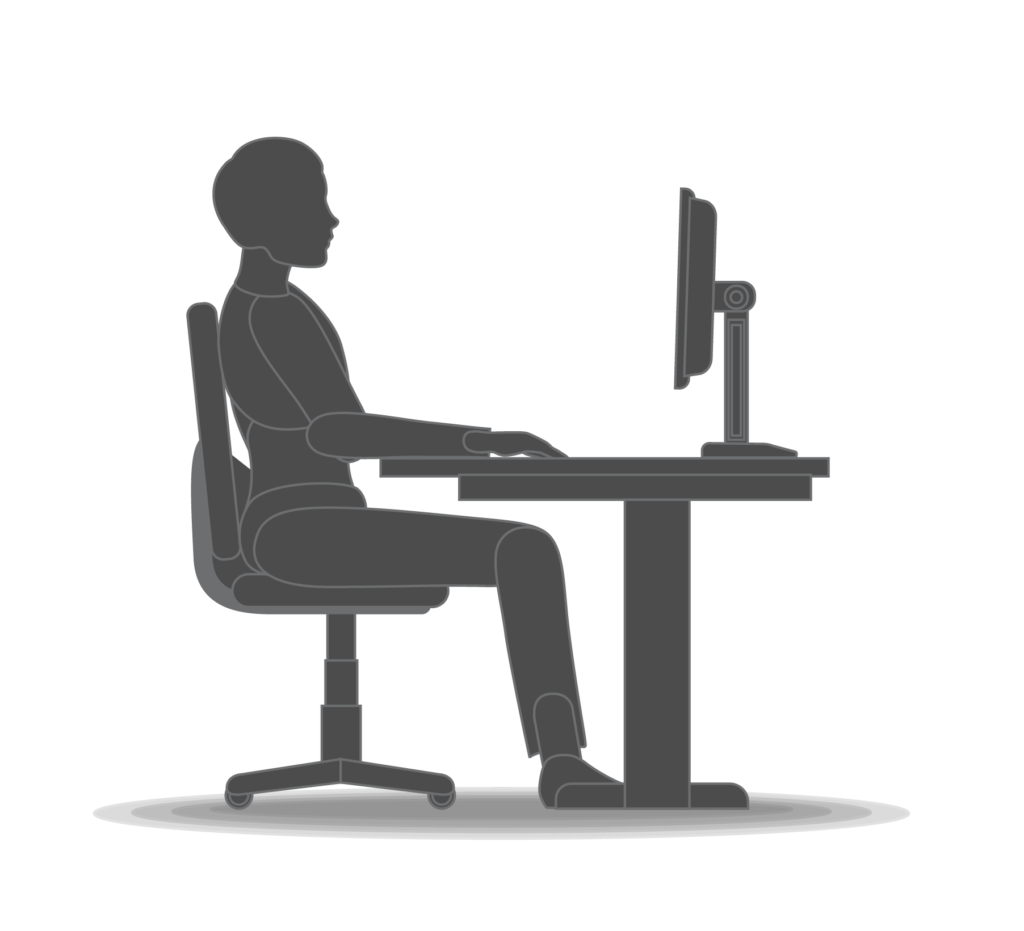
Ergonomic hazards and risks: Our observations and recommendations
Typically, discomfort and injuries associated with poor ergonomic posture take time to manifest.
Over the last 12-months, spurred on by the enforced shift for many from office-based work, to home-based work, our consulting team has increased the ergonomic support and advice we provide – as clients looked for ways to manage the foreseeable hazard.
This period has highlighted to us the great importance of correct computer workstation posture.
To emphasise this, we wanted to provide an overview of common issues we have seen and provide some recommendations for approaches to take to avoid them.
1. Neck and shoulder discomfort
As a result of the worker being seated low in their chair. Effective posture will see you positioned so that your elbows are slightly above the top of your desk when seated (and shoulders relaxed). Seated lower than this required the worker to elevated through the shoulder to access their keyboard.
The common misconception when setting up your workstation is that you position yourself feet flat on the floor, with your knees at right angles; forget it.
The number one rule moving forward is to adjust your seated height, so that your elbows clear the top surface of your desk. If your chair does not adjust, place a pillow on your seat; if your feet are not comfortable on the ground when at this height, purchase a footrest, or locate a box.

2. One-side neck discomfort
As many set themselves up at home, they positioned their laptop in a position based on the video background – as MS Teams or Zoom meetings became a daily occurrence.
For many, the laptop has been positioned to either the right or the left side, meaning that we have rotated regular to this one side. As a result, we have built strength in the muscles on one side of the neck, and stretched the other side of the neck. This results in mis-alignment.
The cure, move the laptop from side to side (consider weekly as a minimum). Force the side you strengthen one week, be the side you stretch the next week. Allow equilibrium.
3. Lower back discomfort
For many, the absence of “water cooler” conversations, has resulted in longer periods of time being seated when working at home, compared to working from the office.
In addition to this, there is a common theme of not wanting to miss an email, or communication (i.e. MS Teams, Slack, etc.) when guidance has been to move periodically through the day.
One issue with prolonged seating is that the right-angle posture made, results in the shortening of the hip flexor muscle. As the hip flexor shortens, the pelvis starts to tilt forward, resulting in discomfort to the lower back.
To mitigate this, move. If you’re a manager, build trust with your team – let them know that if you expect an immediate response, you will contact them directly via phone. If you’re a worker, establish ways to move through the day. Can you stand up when on the phone, or in a video meeting?
General tips to better manage ergonomic risks
Along with these common issues, it remains important to monitor and adjust your workstation set up for optimal comfort and support.
Place your monitor at a height that allows the top third of your screen to be at eye level. If you are using a laptop, consider using an external keyboard and mouse, and raising your laptop screen to achieve the “eye-level” posture.
Your keyboard and mouse should stay within arms-reach. To help you achieve correct alignment, place your keyboard such that you can run a line from the tip of your nose, through your belly button, through your B-Key, through to the stem (or logo) of your monitor.

In addition, if your eyes are sore consider doing the following exercise multiple times through the day; Focus in on an object 20m (or more) away, for 20 seconds. The adjustment in focal length will provide the relief you have not been able to find.
The adjustments above are general in nature. If you do have a medically diagnosed injury, you are more than welcome to consider these suggestions. However, please seek and follow the direction of your treating practitioner.
Our service offering for ergonomic support
If you are looking for workplace ergonomics support, we do have a number of packages that include both virtual and face-to-face delivery.
We would love the opportunity to discuss our offerings, which include:
• One-on-one Ergonomic Assessments
• Ergonomic Training or Webinars
• Workstation Equipment Audits
• Online Training Modules
To find out more, contact info@actionohs.com.au or 1300 101 647.



